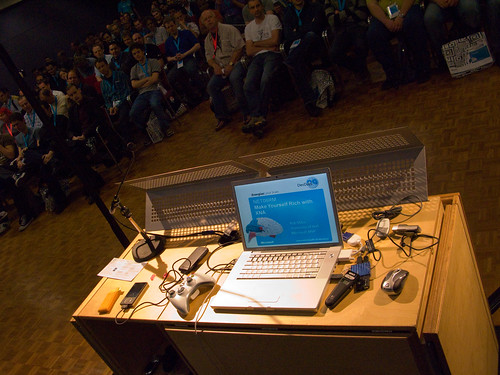I don't usually put up techie pages with code in them, but today I present something that I think might be useful and I've not found anywhere else. It is part of my RSS reader for the XNA display program, and it solves a couple of problems that you might hit. My feed reader needs to read feeds that are on a password protected site, and it also needs to read feeds that are compressed. This method does both:
private StringBuilder readWebPage(
string url,
string username,
string password,
string domain)
{
// used to build entire input
StringBuilder sb = new StringBuilder();
// used on each read operation
byte[] buf = new byte[8192];
try
{
// prepare the web page we will be asking for
HttpWebRequest request =
(HttpWebRequest)WebRequest.Create(url);
if (username.Length > 0)
{
request.Proxy = null;
NetworkCredential credential =
new NetworkCredential(username,
password,
domain);
request.Credentials = credential;
}
// execute the request
HttpWebResponse response =
(HttpWebResponse)request.GetResponse();
// we will read data via the response stream
Stream resStream;
Stream inputStream =
response.GetResponseStream();
// Might have a compressed stream coming back
switch (response.ContentEncoding)
{
case "gzip":
resStream =
new GZipStream(inputStream,
CompressionMode.Decompress);
break;
case "":
resStream = inputStream;
break;
default :
debugOutput.PutMessageLine(
"Invalid content encoding: " +
response.ContentEncoding + " in: "
+ url);
return null;
}
string tempString = null;
int count = 0;
do
{
// fill the buffer with data
count = resStream.Read(buf, 0, buf.Length);
// make sure we read some data
if (count != 0)
{
// translate from bytes to ASCII text
tempString =
Encoding.ASCII.GetString(buf,0,count);
// continue building the string
sb.Append(tempString);
}
}
while (count > 0); // any more data to read?
return sb;
}
catch (System.Net.WebException w)
{
debugOutput.PutMessageLine(w.Message);
return null;
}
catch (System.Net.ProtocolViolationException p)
{
debugOutput.PutMessageLine(p.Message);
return null;
}
catch (Exception e)
{
debugOutput.PutMessageLine(e.Message);
return null;
}
}
This is not very elegant code, but it does work. I've pulled it straight out of the program and so there are a few things you need to know. I have a class called debugOutput which I use to send messages to the user. You either need to create one of your own, or remove those lines. If you need to use a username and password you need to add those to the call, otherwise you can leave those fields as empty strings.




